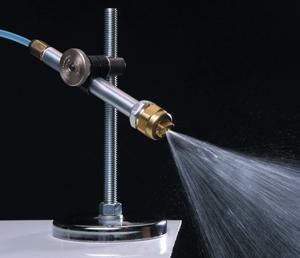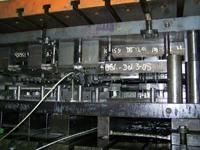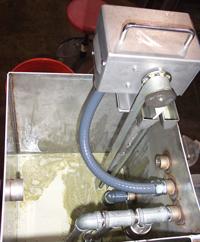- FMA
- The Fabricator
- FABTECH
- Canadian Metalworking
Categories
- Additive Manufacturing
- Aluminum Welding
- Arc Welding
- Assembly and Joining
- Automation and Robotics
- Bending and Forming
- Consumables
- Cutting and Weld Prep
- Electric Vehicles
- En Español
- Finishing
- Hydroforming
- Laser Cutting
- Laser Welding
- Machining
- Manufacturing Software
- Materials Handling
- Metals/Materials
- Oxyfuel Cutting
- Plasma Cutting
- Power Tools
- Punching and Other Holemaking
- Roll Forming
- Safety
- Sawing
- Shearing
- Shop Management
- Testing and Measuring
- Tube and Pipe Fabrication
- Tube and Pipe Production
- Waterjet Cutting
Industry Directory
Webcasts
Podcasts
FAB 40
Advertise
Subscribe
Account Login
Search
10 FAQs about preparing, applying, reclaiming lubricants
Updated mixing devices, processes yield well-oiled machinery
- By John W. Hayes
- June 17, 2008
- Article
- Shop Management

Application nozzles must be oriented correctly to take advantage of electronic lubrication controls.
Lubricant application can be both expensive and time-consuming. Disposal practices are wasteful and often incur additional costs. Are you missing the collection pan? It might be time to ask some questions about your lubrication methods. A three-tiered process of preparing, applying, and reclaiming lubricant can help you to save both time and money.
Lubricant Preparation
1. How can I mix a precise water-to-lubricant-concentrate mixture economically?
You can achieve proper proportional mixing only through sound mechanical means. Proportional mixers inject a measured volume of lubricant concentrate into a measured volume of water, producing a fixed mixture.
These mixtures are based on known volumes of lubricant concentrate and water only, and not on the refractive index of the mixture. You need to know the viscosity of the lubricant being mixed, the lubricant's solubility, the desired mixture ratio, and the total volume requirement.
2. What mechanical means produce a proper mixture?
Effective, accurate proportioning and thorough mixing of medium- to heavy-viscosity lubricant concentrates require positive-displacement gear pumps coupled with a drive transmission and supplied with stabilized water and a stabilized lubricant concentrate source (see Three Steps to Proper Lubricant Proportioning sidebar).
3. How do I distribute mixed lubricant to the production machinery safely, and what are the benefits of a closed-loop style of system?
The preferred method distributes lubricant from a central location. It passes through a piping network and is delivered to each individual press. Before entering the piping network, the lubricant must be pressurized. As the mixture exits the water pump, a back-pressure device such as a pressure accumulator is added, causing the lubricant pressure in the distribution line to increase to the required pressure (60 pounds per square inch). As required, the lubricant will flow, under pressure, to each production cell.
The benefits of a closed-loop system are numerous. Accurate and thoroughly mixed lubricants are produced at a central location and distributed throughout the manufacturing facility for use at each press. No labor costs are associated with the process; an ample supply of lubricant is consistently present at each press; and no problems with waste, housekeeping, or accidents are associated with lubricant delivery.
Lubricant Application
4. How do I manage the volume of lubricant applied to my stock or tooling at each press?

Figure 1 A quick-disconnect style of coupler attaches the in-die nozzles to the application control.
The optimal method of controlling lubricant application involves microprocessor-based electronics coupled with high-speed injector valves. These tools allow you to micromanage each lubricant application phase. Electronically controlled injector valves facilitate a precisely metered volume of lubricant where and when it is needed.
5. How can I incorporate one system that works for all of my press and tooling combinations?
Microprocessor-based electronics and data memory allow you to save and recall lubricant application profiles after you have defined the profile. You can store 60 profiles using independent data tables and part number combinations.
6. How can presses from different manufacturers and the lubricant control device "communicate"?
Programmable logic controllers can communicate with each other by using simple binary communications. Binary communications enable the PLC to initiate data tables within the lubricant control PLC. Each data table includes a corresponding application profile and programmed part number. When the press controller generates a part-specific binary signal, the lubricant application control initiates the proper part number and application program.
7. I plan to install lubricant application nozzles within my tooling. How can I change my tooling in a minimal amount of time yet ensure my lubrication system is coupled properly?
Electronic lubrication control is effective and efficient; however, because you can program each application nozzle independently and save and recall application profiles, you must orient the application nozzles correctly. Using in-die placement of application nozzles compounds the problem because you can't swap magnetically placed nozzles conveniently.
To resolve this problem, use a quick-disconnect style of coupler, which attaches the in-die nozzles to the application control (seeFigure 1). The couplers must be assembled within a nest that includes orientation devices for proper coupling placement.
Lubricant Reclamation
8. How do I minimize the amount of lubricant entering my press pits?
The best way is to minimize the amount of wasted lubricant by controlling the application process; however, that can be easier said than done. As an alternative, you can place collection troughs and trays strategically around the presses, conveyors, and parts-collection bins to minimize the amount of lubricant entering the pits. These containers can empty into a floor-level collector for ease of handling.

Figure 2: A mechanical device that addresses each segment of the reclamation process is the preferred way to reclaim lubricants. It separates the metal fines and large contaminants; separates and disposes of tramp oils; and filters and then reintroducing lubricants.
Another method of collecting waste lubricant that enters the pit through the tooling is to install a collection pan under the press bed. The pan would incorporate a sump-style pump to pump waste lubricant on demand to a centralized collector.
9. How can I reuse lubricant?
Lubricant reclamation is becoming the standard in a sound lubricant management system; however, you may encounter pitfalls when addressing this issue. The volume of lubricant collected is proportional to the reclaimed volume. Therefore, the lubricant must be collected and prepped for recycling as soon as possible. Allowing the lubricant to collect and sit degrades its quality.
You need to collect and deploy the lubricant quickly—it should not remain dormant for more than 24 hours. Dormant lubricants generate bacteria, and bacteria causes lubricant degradation.
10. How do I remove contaminants—including cigarette butts and metal shavings—before recycling lubricant?
The preferred method is a mechanical means that addresses each segment of the reclamation process (see Figure 2).
Remove Contaminants. You need a magnetic strainer device to separate the metal fines and the large contaminants. After you remove these items, convey the lubricant to reservoirs for the second phase.
Separate and Dispose of Tramp Oils. Water-based lubricants will segregate themselves from the tramp oils given ample time. The time associated with this separation differs depending on lubricant type. You can reduce separation time by using a coalescing filter; however, because oils attach to the filter, you should clean coalescing filters periodically so they remain efficient.
After separating the oil from the lubricant, remove and discard it. You can use absorption devices (skimmers) strategically placed in the holding reservoir or elevate the lubricant in the reservoir to spill off the tramp oils.
Filter and Reintroduce Lubricant. Final-stage filtration removes the minute particles that pass through the magnetic strainer. The most effective tool is a bag-style filter using a 5-micron filter bag.
When the reclamation process is complete, reintroduce the lubricant. Because manufacturing demands the highest grade of lubricant possible, you should blend the reclaimed lubricant with a virgin mixture. Expediency is key, so blending should occur at the central mixing station. Depending on the volume of lubricant reclaimed, the mixture by percentage of reclaimed lubricant to virgin mixture should be 25 percent to 50 percent, respectively.
Three Steps to Proper Lubricant Proportioning
Liquid Stability. First, before mixing the water and lubricant concentrate, be sure that both liquids are stable to achieve the desired result.
Reservoirs are the most effective tools to use when liquid stability is required. The water reservoir maintains an ample supply of water before the mixing process and eliminates any inconsistency in water pressure. The lubricant concentrate reservoir ensures an ample supply of the concentrate is present and also can be used to preheat the lubricant concentrate, which results in stable viscosity.
Emulsion. Second, nonmechanical methods (stick and bucket) will blend to a certain extent, but you can accomplish thorough blending only by a mechanical means. Two positive-displacement gear pumps are used to do this.
As an example, the lubricant concentrate gear pump meters a volume of 1 gallon per minute (GPM), as the water gear pump meters 11 GPM. The lubricant concentrate (1 GPM) is injected into the suction side of the water pump (11 GPM), initiating the mixing process. As both liquids pass through the gears of the water pump simultaneously, the water and the lubricant concentrate are sheared hydraulically into suspension or solution. The blended lubricant exits the water pump at a mixture of 10-to-1, accurately and thoroughly mixed.
Mixture Modification. Third, modify the mixture by either increasing or decreasing the volume of water or increasing or decreasing the lubricant concentrate. You attain optimal accuracy by adjusting the volume of water.
For example, if production dictates a 10-to-1 10:1 mixture of water to lubricant concentrate, you maintain greater accuracy by modifying the larger volume—the 10 parts water—instead of the 1-part lubricant concentrate.
About the Author
John W. Hayes
2650 Thornwood St.
Wyoming, MI 49519
616-249-1525
subscribe now

The Fabricator is North America's leading magazine for the metal forming and fabricating industry. The magazine delivers the news, technical articles, and case histories that enable fabricators to do their jobs more efficiently. The Fabricator has served the industry since 1970.
start your free subscription- Stay connected from anywhere

Easily access valuable industry resources now with full access to the digital edition of The Fabricator.

Easily access valuable industry resources now with full access to the digital edition of The Welder.

Easily access valuable industry resources now with full access to the digital edition of The Tube and Pipe Journal.
- Podcasting
- Podcast:
- The Fabricator Podcast
- Published:
- 04/16/2024
- Running Time:
- 63:29
In this episode of The Fabricator Podcast, Caleb Chamberlain, co-founder and CEO of OSH Cut, discusses his company’s...
- Industry Events
16th Annual Safety Conference
- April 30 - May 1, 2024
- Elgin,
Pipe and Tube Conference
- May 21 - 22, 2024
- Omaha, NE
World-Class Roll Forming Workshop
- June 5 - 6, 2024
- Louisville, KY
Advanced Laser Application Workshop
- June 25 - 27, 2024
- Novi, MI































